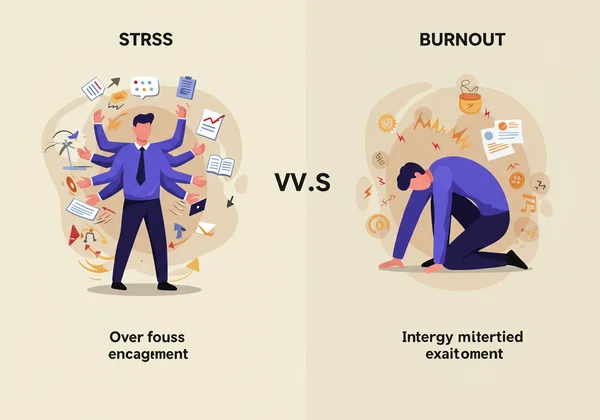How to Recover From Burnout: A 10-Step Guide for Well-being
Feeling perpetually overwhelmed, emotionally drained, and disconnected from your work? You are not alone. This profound exhaustion is the signature of burnout, a state of emotional, physical, and mental exhaustion caused by prolonged stress. It goes far beyond feeling tired.
The good news is that burnout recovery is not only possible but within your reach. This guide provides a clear, 10-step framework to help you navigate from exhaustion back to engagement and well-being. The first step on any journey is knowing your starting point. Our science-backed assessment can provide the clarity you need to begin.
Discover your personalized insights by taking our free Burnout Test today.
Understanding Your Burnout: The Crucial First Step
You cannot fix a problem you don't fully understand. Before jumping into solutions, it’s vital to acknowledge and identify the specific nature of your burnout. This self-awareness isn't about blame; it's about empowering yourself with the knowledge needed for a sustainable recovery.
Recognizing the Signs: What Does Burnout Feel Feel?
Burnout fatigue isn't the kind of tiredness that a good night's sleep can cure. It’s a deep, pervasive exhaustion that seeps into every area of your life. Recognizing these symptoms is the first signal that you need to take action.
-
Emotional Exhaustion: Feeling cynical, detached from your job, irritable, and emotionally blunted. You may experience a sense of dread about the workday ahead.
-
Mental Drain: Experiencing "brain fog," an inability to concentrate, difficulty making decisions, and a noticeable loss of creativity or problem-solving skills.
-
Physical Depletion: A constant lack of energy, frequent headaches or muscle pain, stomach and gut issues, and a weakened immune system leading to more frequent illnesses.

Burnout vs. Stress: Understanding the Difference
It's easy to confuse burnout with stress, but they are fundamentally different states. Misidentifying your condition can lead to guilt and ineffective solutions.
-
Stress is often characterized by over-engagement. You feel a sense of urgency and hyperactivity. Your emotions are heightened, and you may feel anxious and overwhelmed, but you are still fighting to keep up.
-
Burnout, in contrast, is characterized by disengagement. Instead of hyperactivity, you feel helpless and detached. The fight is gone, replaced by emotional exhaustion, blunted feelings, and a profound loss of motivation.

Acknowledging that you are experiencing a state of depletion—not laziness—is an essential act of self-compassion and the true starting point for how to fix burnout.
10 Actionable Steps for Your Burnout Recovery
Once you have identified your state, you can begin implementing targeted burnout coping strategies. These steps are designed to stop the energy drain, replenish your resources, and build a more resilient foundation for the future.
Step 1: Prioritize Genuine Rest
True rest is more than just sleep. Burnout recovery demands multi-faceted rest, including mental, emotional, and sensory breaks. This means scheduling time where you are not problem-solving, worrying, or thinking about work. It could be a quiet walk in nature, listening to calming music, or simply sitting in silence without a screen. Give yourself permission to be unproductive; this is when your mind and body truly begin to heal.

Step 2: Set and Enforce Healthy Boundaries
Burnout thrives in an environment of weak or non-existent boundaries. Protecting your time and energy is non-negotiable for recovery. This involves defining clear work hours and sticking to them, learning to say "no" to non-essential requests, and disabling work notifications on your personal devices. Setting effective boundaries is easier when you know your specific stress triggers, which a workplace stress test can help you identify.
Step 3: Reconnect with Purpose Beyond Your Job
When your job becomes your sole source of identity, burnout can feel like a complete personal failure. A powerful antidote is to reconnect with your values and find meaning in activities outside of your profession. Rekindle old hobbies, learn a new skill like painting or a language, volunteer for a cause you care about, or spend quality time on relationships that fulfill you. These activities provide a sense of accomplishment and remind you that your worth is not tied to your productivity.
Step 4: Identify and Reduce Key Stressors
Take a clear-eyed look at your work and life to identify the biggest sources of stress. Are you dealing with an unmanageable workload, a lack of control over your tasks, or a toxic work environment? Once identified, take concrete steps to reduce your exposure. This might involve talking to your manager about your workload, improving your time management systems, or creating distance from negative colleagues.
Step 5: Delegate Tasks and Share the Load
The belief that you must do everything yourself is a major contributor to burnout. Practice the art of delegation at work and ask for more help at home. Identify tasks that others can reasonably take on. This not only lightens your load but also empowers others and fosters a more collaborative environment.
Step 6: Rebuild Your Physical Health
Chronic stress depletes your physical resources. Actively rebuilding your health is a core part of recovery. Focus on the fundamentals: a balanced diet to fuel your brain and body, regular physical activity to reduce stress hormones, and consistent sleep hygiene to promote restorative rest. Even small changes, like a 15-minute daily walk, can make a significant difference.
Step 7: Foster Supportive Relationships
Isolation fuels burnout. Make a conscious effort to connect with supportive friends, family, or mentors. Sharing your experience with people you trust can reduce feelings of shame and loneliness. Schedule time for social connection that is purely for enjoyment, with no agenda other than to connect and have fun.
Step 8: Cultivate Resilience with Mindfulness
Building resilience helps you handle stress more effectively in the future. Techniques like mindfulness meditation, journaling, and deep-breathing exercises are powerful tools for regulating your nervous system. These practices teach you to observe your thoughts and feelings without judgment, creating a crucial buffer between a stressful event and your reaction to it.

Step 9: Re-evaluate Your Career Alignment
Sometimes, burnout is a sign of a fundamental mismatch between you and your job. Take time to reflect: Does your work align with your core values? Does the company culture support your well-being? Is there room for growth? Answering these questions honestly may reveal that true, long-term recovery requires a significant change, such as redefining your role or even finding a new career path.
Step 10: Seek Professional Support When Needed
While self-help strategies are powerful, sometimes they aren't enough. If your symptoms are severe, persist despite your best efforts, or leave you feeling hopeless, it is a sign of strength to seek professional support. A therapist, counselor, or coach specializing in occupational health can provide expert guidance, proven tools, and a safe space to navigate your recovery.

Your Path to Reclaiming Well-being Starts Now
Burnout recovery is a journey of small, intentional steps. It begins with the courage to acknowledge your exhaustion and the wisdom to understand its roots. By prioritizing rest, setting boundaries, reconnecting with your purpose, and seeking support, you can systematically reclaim your energy, engagement, and joy.
The very first step is gaining clarity. Don't guess about your mental state. Let our science-based burnout test help you understand your unique profile of exhaustion and disengagement.
Discover your burnout profile and start your personalized recovery journey today.
Disclaimer: This guide is for informational purposes only. The test is a self-screening tool and not a substitute for professional medical diagnosis or treatment. Please consult a qualified healthcare provider for any health concerns.
Frequently Asked Questions About Burnout Recovery
How to fix burnout effectively?
Effective recovery requires addressing both the symptoms and the root causes. It involves a combination of immediate rest to stop the energy drain, reducing exposure to the core stressors causing the issue, and actively rebuilding your physical health, emotional resilience, and supportive relationships.
How to recover properly from burnout?
Proper recovery is a holistic process. It means prioritizing deep rest, setting firm work-life boundaries, reconnecting with meaningful activities outside of your job, and developing long-term stress management skills like mindfulness. For a personalized starting point, you can take our free burnout test to see which areas need the most attention.
What are the three R's to coping with burnout?
The "Three R's" is a simple framework for recovery: Recognize the signs and acknowledge the problem. Reduce your exposure to the stressors causing burnout by setting boundaries and changing your environment. Rebuild your resilience by focusing on your health, relationships, and coping skills.
How can I stop feeling burnt out quickly?
While full recovery takes time, you can take immediate steps for relief. If possible, take a few days completely off work. Unplug from digital devices and notifications. Engage in a deeply relaxing, non-demanding activity you enjoy. This creates the initial space needed to begin a more structured recovery process.
How long does burnout recovery take?
The timeline for burnout recovery varies greatly depending on the severity of the burnout, the individual's circumstances, and the changes they implement. It can range from a few months to a year or more. The focus should be on making steady, sustainable changes rather than searching for a quick fix.
When should I seek professional help for burnout?
You should seek professional help if your symptoms are severe, persist for several weeks despite your efforts, or if you feel unable to cope on your own. A doctor or therapist can provide a proper diagnosis, rule out other conditions like depression, and create a structured treatment plan tailored to you.